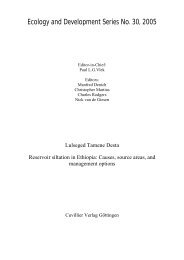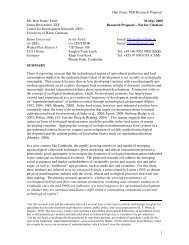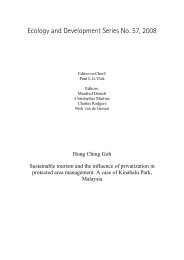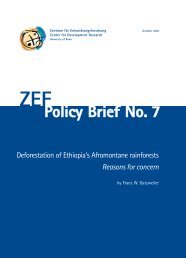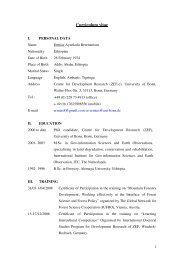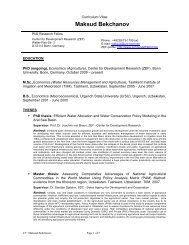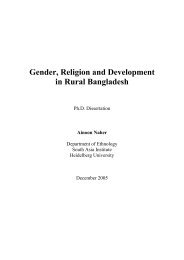Ecology and Development Series No. 10, 2003 - ZEF
Ecology and Development Series No. 10, 2003 - ZEF
Ecology and Development Series No. 10, 2003 - ZEF
- No tags were found...
You also want an ePaper? Increase the reach of your titles
YUMPU automatically turns print PDFs into web optimized ePapers that Google loves.
Floristic analysis of the undisturbed forestAdditionally, the mean difference in environmental variables among thecommunity types was tested using one-way ANOVA <strong>and</strong> Duncan’s multiple range tests.The relationships between the environmental variables themselves <strong>and</strong> their relationshipwith the most characteristic species of each group or community type were also tested usingPearson’s correlation coefficient. The environmental variables used in these analyses arealtitude, slope, silt, clay, soil moisture content, soil pH, CEC, C-N ratio <strong>and</strong> distance fromGeba river. Methods for collecting the environmental data are described in chapter 3.2.1.4.3 Results4.3.1 Floristic compositionA total of 220 species of flowering plants, a conifer <strong>and</strong> ferns representing 73 families wererecorded from the study area (For the list of all plant species from the area <strong>and</strong> thevouchers, see Appendices 1 <strong>and</strong> <strong>10</strong> respectively). Out of these, there were 71 tree, 28 shrub,27 climber <strong>and</strong> 94 herbaceous plant species. The only conifer recorded in the area isPodocarpus falcatus; it was, however, not recorded in the sample plots. Likewise, manyspecies are rare in their occurrence <strong>and</strong> hence, only 160 species, representing 50 families,were recorded in the study plots. Of these, <strong>10</strong>2 species were woody plants (trees, shrubs<strong>and</strong> climbers). Quantitative data were collected for trees, shrubs <strong>and</strong> climbers species <strong>and</strong>analyzed (Table 4.1,). The results <strong>and</strong> subsequent discussions in this study are restricted tothese <strong>10</strong>2 woody species, unless otherwise mentioned.Among the woody plants, trees are the dominant growth form, represented by 59species (57.8%), followed by shrubs (24 species, 23.5%) <strong>and</strong> climbers (19 species, 18.6%)(Table 4.1). All species recorded in the study plots are native. Most tree species have awidespread distribution (Table 4.1, Appendices 1 <strong>and</strong> 2). There are also many tree specieswith a restricted distribution range as either endemic or near-endemic (with somepopulations occurring in other floristic regions) to the Afromontane forest region (Table 4.1<strong>and</strong> Appendix 1).The summary of abundances, frequencies <strong>and</strong> basal areas of all plant species usedin quantitative analysis, including distribution types of tree species is presented in Table4.1. A few species of trees, shrubs <strong>and</strong> climbers dominate the forest vegetation. About 50%41





